| Abstract: When people study surround sound, they decide to set up rear channels to compensate for these mixes. In this way, during the recording process, more microphones need to be added, which means that more speakers are needed to restore the sound during playback, which involves the positioning of multi-channel speakers. |
Now, many game or HDTV enthusiasts choose multi-channel speakers for their systems, in order to get a more realistic sound field effect. So, what are the advantages and disadvantages of surround sound compared to ordinary stereo? This will start from the stereo recording. Strictly speaking, stereo recording has high requirements on the angle of the microphone. It is generally required that the sound directly entering the microphone and the sound reflected back through the room should reach an appropriate ratio, so that the recorded sound will have a strong sense of space. However, in the actual stereo recording, it is difficult to achieve a proper ratio of the sound directly into the microphone and the sound reflected back through the room. The main problem is that in the late mixing, various signals are mixed together. In fact, various sounds are mixed after entering the ear canal. In stereo recording, the most easily lost is the sound reflected back through the room, and it just determines the spatial sense of the sound. Therefore, when people study surround sound, they decide to set up rear channels to compensate for these mixes. In this way, during the recording process, more microphones need to be added, which means that more speakers are needed to restore the sound during playback, which involves the positioning of multi-channel speakers.
The placement of multi-channel speakers is directly related to listening quality. Even a little difference will cause a great change in the sound field. Although the desktop theater is a near-field listening, it is not very sensitive to the shape and volume of the space, as well as the diffraction and absorption of furniture and other objects, and the speaker placement is relatively free. Let's take 5.1 speaker system as an example to illustrate the placement of multi-channel speakers.
Positioning of the front speakersThe front left and right main channel speakers are placed in an isosceles triangle shape, and the bottom side is 1.5m ~ 2.0m long. If the two front speakers are too close to each other, what the human ear hears is only the direct sound field effect of the speaker, and the rendering effect of the reflection passing through the wall and surrounding space is not heard. The sound is inevitably dry and mixed. Even if it is reflected by the wall, because you are too close to the sound field, the diffracted sound is also covered, which is difficult for you to hear. In general, the two main speakers are best at an angle of 45 ° to the listener. If the speakers are too close to the listener, the sound range positioning is inaccurate, and the high and low units have a phase difference, and the sound is not synchronized; the distance is too far. The field will become narrower, losing the sense of space and presence.
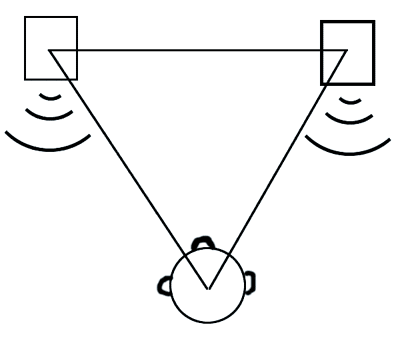
The positioning principle of the center speaker is very simple: it is placed directly in front, which is the vertical bisector of the left and right speakers, in the same plane as the left and right channel boxes, and is generally placed above the display (Figure 2).
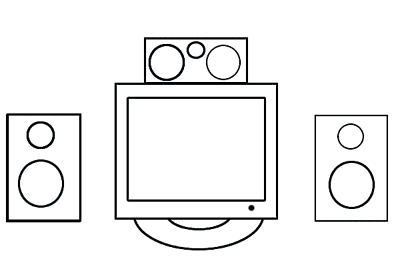
Rear left and right surround speakers should be placed on the rear wall on both sides. If possible, use the speaker stand to frame the surround box as high as possible with the left and right main speakers. The arrangement is also based on the isosceles triangle arrangement, the distance between the bottom and the main speakers is equal or slightly longer. The rear speaker should be placed at an angle of 110 °. The reason for this placement is that the angle of the human ear is approximately 110 °, and the rear speaker mainly plays back the sound from the back, so the placement of 110 ° is closer to the real Effect.
For many computer players, the space behind is limited, and it is unlikely to be used for rear speakers. Even if there is space, whether it can be placed at exactly 110 ° is a big problem. To this end, you can use the following "compromise" program.
For those without space behind, you can “reverse†the rear speakers to the front, that is, the mirror symmetry between the front and the original rear. If there is rear space but cannot be placed at 110 °, it can be placed at a position behind without following the 110 ° specification. If the rear speakers cannot be on the same plane, the height of the rear surround speakers can be about 60 ~ 90 cm higher than that of the listener. But try to avoid situations where the height is below the human ear. Subwoofer positionThe placement of the subwoofer is much looser because the directionality of the bass is relatively weak. The placement of the subwoofer can be irrespective of the position, but the position does not mean that it can be randomly placed. Generally speaking, when the subwoofer is placed close to the wall, it will have a more average bass performance. It is recommended to place the subwoofer in the center of the desktop with the box facing backwards, the effect will be better. Because the bass will reach the human ear after two reflections, this will make people feel that the sound field is stretched, and the sense of presence is stronger.
5.1 Overall diagram of speaker system positioning:
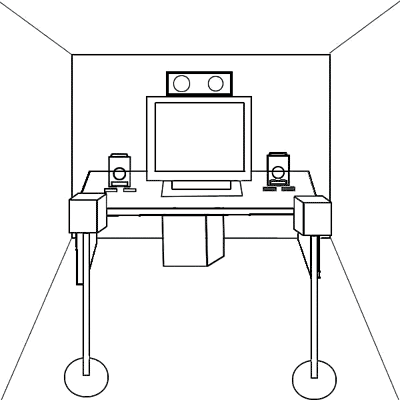
6.1 Positioning of speakers
Compared with the 5.1 sound system, the 6.1 sound system has an additional rear center speaker. The speaker placement requirements are the same as the center speaker. Therefore, the placement of 6.1 speakers is relatively simple, which is to add a rear center speaker based on the placement method of 5.1 sound system.
It should be noted that due to the addition of the rear center speaker, the rear sound is enhanced. Therefore, the random placement of the rear speakers of the 6.1 sound system will not affect the effect too much, so the effects of various "compromise" schemes have been strengthened and are closer to the ideal scheme. This is also the biggest advantage of the 6.1 sound system over the 5.1 sound system. Too.
7.1 Placement of speakers
Compared with the 5.1 sound system, the 7.1 sound system adds two side center speakers while retaining the original rear speakers, mainly responsible for the playback of side sounds, and the original rear speakers can focus more on the playback of the rear sound, so 7.1 The sound system can achieve sound playback on all four sides, and the surround effect is further enhanced.
For many music lovers, the high-quality 2.0 speaker system is still the best choice for music appreciation. For music playback, the 2.0 bookshelf box does have a considerable advantage. Many people like to use the 2.0 bookshelf box to listen to music. However, if the positioning is not appropriate, the advantages of 2.0 speakers will not be exerted at all. Proper positioning can maximize the perfect sound quality of 2.0 speakers. Next, let's take a look at how to put 2.0 speakers.
Don't just use bass gain
It is not an extra large room, and it is not recommended to use bass gain, otherwise the sound will be low and feel muddy. The bass control knobs of some 2.0 speakers have no gain at the minimum scale, not the 12 o'clock position. This point needs attention.
Keep a certain distance between speakers
Since 2.0 speakers have a large power and can create a large sound field, it is recommended to keep two speakers away from a certain distance, 80 ~ 120cm is better (Figure 1), do not stack large objects in front of and behind the speakers, as easy as a CD box It is best to keep the vibrating things away from the 2.0 speaker. The CD box will also generate a slight noise when it vibrates. Some uneven desktops may be difficult to stabilize 2.0 speakers. It is recommended to use soft rubber cushions to achieve a stable placement.
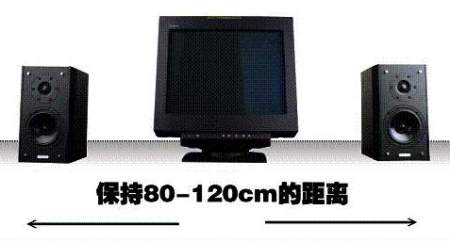
Distance from wall is greater than 30 cm
Many 2.0 speakers are speakers with a rear-inverted structure. The inverting holes point to the rear. When the speakers are working, the airflow will be discharged through the inverting holes, especially when high power is output. When the airflow hits the rear wall, it will cause the bass to be turbid and become unpleasant. To get a better hearing, it is recommended to keep the rear panel of the speaker at least 30 cm away from the wall. If space is limited and it cannot be placed at a suitable distance, you may wish to hang a tapestry on the wall, which can also help improve the bass sound quality.
Speakers as far as possible
Like other waves, sound waves can be reflected and diffracted and recombined with other waves. When the speaker is placed at the rear of the desktop, the sound waves emitted are easily reflected by the desktop, which will also make the bass become muddy, the sense of speed becomes worse, and the overall sense of hierarchy becomes worse. Putting the speaker closer to the front can greatly improve the sound quality, because the desktop has less reflection and the sound is much clearer.
Keep the near sound field at a certain angle
The human ear can easily hear the direction of the treble sound source and the direction of the treble. When the speakers are placed in parallel, it is suitable for viewing in the far sound field (more than 1 meter), and most computer users are listening in the near sound field. Turning to the inside, the speaker is roughly directed towards the user. In this way, you can hear more high-pitched sounds, which can help improve the sound resolution and make the bass sound more powerful. The sound quality will be greatly improved.
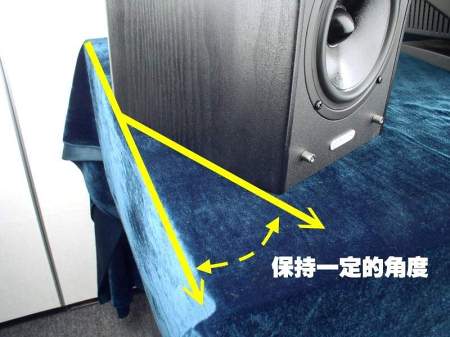
Pay attention to the above points, or you will find that the speakers that you always think that the sound quality is not satisfactory are actually very good, but you have not realized its potential. After readjusting, you can make your 2.0 speakers perform better and get more enjoyment of listening to music.
Made is Jiangsu, China, we produce a wide range of automotive wires with the applications of LED, instrument, ignition system, ESP & ABS, seat heating and window control that meet UL, VDE, JASO standard, also OEM specifications. Our PVC insulation is tough enough to resist grease, oil, and acid according to ISO6722, and has a temperature rating of 176°F (80°C). If you need a higher temperature and performance wire, use cross-linked wire instead. Each bare copper wire core is composed of pure copper with high conductivity, flexibility, and durability. Packing is available in small bundles, and larger spools.
Automotive Wire
Automotive Wire,Vehicle Wiring,Car Electrical Wiring,Bus Wire
Feyvan Electronics Technology Co., Ltd. , http://www.fv-cable-assembly.com